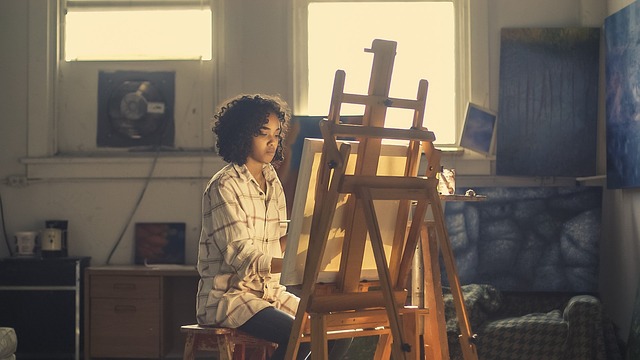You are required to submit a portfolio of your art work: sculpture, painting, photography, etc. Or, you are considering sending in a portfolio to demonstrate your talent as a supplement to your college application to make your candidacy more competitive.
Submitting a portfolio is not easy, and the process probably began in your sophomore or junior year, building your portfolio materials and deciding how to make your portfolio wide-ranging and varied. But, now you have to get it done!
What is the best way to present yourself in your portfolio and how do you present yourself well?
You might want to start by looking at how a portfolio fits into a college application. (See our article, “What is a Portfolio and How Does it Fit with my College Application?” ) This article will cover how to present yourself in the art portfolio best and will offer some great insider tips.
Whatever you do, give yourself at least three weeks to get your art portfolio completed and sent in a timely fashion, and do it well before the deadline!
Presenting Yourself is about Selection
First, you must be sure to select work to show the quality of your art. You will want to showcase your various strengths: composition, line, use of color, etc; the quality of your work: maturity, thoughtfulness, subject choice; and the range of your ability: variety, growth, different subject matter, media choice, etc.
Here some other things to consider.
- If you are applying for Early Decision, show the best examples of your work to date. Choose accordingly, but also keep in mind the schools are aware of your time limits.
- Do not select too much work; 12 – 16 images are usually enough.
- Consider the quality of the schools you are applying to. You might select certain work for your reach schools, but some of that work may be too experimental or too over-the-top for the medium range schools.
- Get input from your teachers about what best represents your strengths. Don’t rely on friends’ opinions. You need expert advice.
- Think about including your new work with some older things to show growth or problem solving ability.
- Too much of the same is not good. All portraits—no! All oils—no, again! You need to show you have ability to do more than one thing. (However, if you are a portrait painter, then variety might mean including subjects from different points of view, use of different materials, or significantly varied compositions.)
- Be careful about detail images. To include two images of one piece of art may be useful if you have real reason to include the detail—because it shows a technique or skill that is unusual–; otherwise, you are wasting CD space.
Second, you also have to select work that will photograph well. Your work will only look as good as it appears in your digital image.
Pencil drawings do not come out well in slides or digital images. Make sure there is strong color for your picture images.
Another thing that ensures a good image is good contrast of light and dark.
A Well-presented Portfolio is the Product of Good Photography
- With a little help, you should be able to prepare the digital portfolio yourself, but if you feel too inexperienced, find an experienced person to help you.
- Begin by reading the application instructions carefully about how the portfolio is to be presented. Each application could vary. If you do not understand the particulars of the instructions or they are not complete, call the college’s admission office for clarification before spending the time and money to have your portfolio prepared. Some schools expect a CD of your portfolio and some have a website to upload images to. Either way, be sure to follow size and resolution requirements.
- Make sure you find a good digital camera. You also can not just use any photographer. The photographer must know something about reproducing art. For example, the photographer should be aware of the importance of lighting, especially for 3-dimensional pieces like sculpture or jewelry. This person should understand about different effects that might show your art work off better. You should also ask to see this person’s work before hiring him or her, if you are hiring someone. Check for clarity, color, and focus. Hiring a photographer will be expensive. You probably know someone with a photgraphy background to help you. Your art tecaher should be able to give you good advice here.
- Decide, within the limits of the application requirements, which way to prepare and send your portfolio. If you have a choice, it is usually best to put the portfolio on a CD; then it is easy to copy it as many times as needed for applying to multiple schools.
- Be careful to make sure that each slide is filled with only the image; there should be no white or blank spaces around the edges. Such space will distract from the image of your art. Crop and organize the images well to show what is best in each image. You need to show off your strengths as an artist. Mix up color with black and white, portraiture with figure work. Be sure to show a variety of media, processes, and subject matter. Most art schools and others prefer to see some examples of traditional subject matter (observation work of portrait, figure studies, still life, etc.) as well as your more personal work.
- Prepare an inventory list for each of your images carefully, including all the necessary information: title, size, and media used. This inventory can be loaded onto the CD.
- Include an essay statement which explains your philosophy about your work, why you are sending the portfolio, and a self analysis of your work and progress. This artist statement can be uploaded on the CD also.
- Some people like to design a cover for the CD. The cover should include your name and other information you want and a visual that might attract the interest of the portfolio evaluator.
Bonus Insider Tips
- If you want the school(s) to return your CD, be sure you include a self-addressed, pre-stamped envelope for the return. Schools do not return CDs generally due to the numbers of applications and portfolios they receive.
- To augment your application, be sure to explain in your statement why you think it is important for the admissions people to see your work.
- Include only strong work. It is better to show only 10 strong pieces than 30 so-so art works.
- Remember to include sketchbook pages that show something of your process and/or thinking and planning stages.
- Early on it might be wise to visit the school(s) you are applying to in person. Ask for an appointment or portfolio review. You can learn a lot about the school, its porgram, and what the professors are expecting from you as a student in such a face-to-face meeting. You will also have an opportunity to show them original work, which is a plus for you, although you may still have to turn in a portfolio CD with your application.
- Some students have created a website of their work. If you have one, you should provide that information for the admissions people. They might take the time to check it out.
- Save a backup of your portfolio CD to use for later applications. In fact, you should always keep a digital record of your work.
- You already know sketches in pencil are not going to yield high quality slides, but if you want to include pencil drawings, you might photocopy them for a darker image or redo them in ink.
Now, break a paint brush!
Information provided by Kal Elmore, high school Art Department Head







